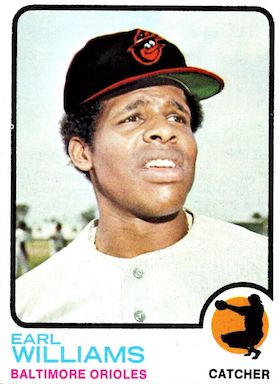
Sport: Baseball
Born: July 14, 1948
Died: January 28, 2013
Town: Montclair, New Jersey
Earl Craig Williams Jr. was born July 14, 1948 in Newark, NJ. His family moved to Montclair, where he became one of the state’s best all-around athletes. He was a great basketball player, football player and baseball pitcher for Montclair High School—then, as now, a racially diverse student body oozing with talent. Among Earl’s schoolmates was Joe Walsh, the future lead guitarist of the Eagles.
Earl was recruited as a basketball guard and accepted a scholarship to Ithaca College in 1965. However, after being drafted in the first round by the Braves that spring, he decided to become a pro athlete. One of his childhood heroes was Hank Aaron; the chance to play beside him was just too tempting. The Braves agreed to pay Earl’s college tuition, and he attended classes in the off-season.
Earl tried his hand at pitching in the minors, but it soon became clear that it was his bat that would get him to the majors. The only problem was that he did not have a position. The Braves tried him at first, third and the outfield, with mixed results. Earl hit 57 homers during the 1969 and 1970 minor-league seasons, forcing a call-up to Atlanta in September of 1970. He hit .368 in 10 games.
The Braves wanted Earl in the lineup every day in 1971, but with Aaron and Orlando Cepeda at first and Darrell Evans manning third, there wasn’t any room in the infield. The Braves’ outfield was crowded, too, with speedsters Ralph Garr and Sonny Jackson holding down left and center, and Mike Lum in right. To solve this dilemma, the Braves did the unthinkable—they asked Earl to try playing catcher.
Earl had no idea what he was doing, but being a good athlete and anxious to play, he agreed. He made the switch in June, and held his own defensively (even when Phil Niekro was on the mound). At the plate, Earl went on a tear over the last three months. He hit 24 homers after the position change to finish with 33. He knocked in 87 runs and batted .260—numbers good enough to edge Willie Montanez for Rookie of the Year honors. That season, Earl blasted a home run into Fulton County Stadium’s upper deck. It was the last time anyone accomplished this feat.
Earl never became a good defensive catcher, and often griped about playing the position. He had trouble keeping weight off, which made crouching for nine innings all the more miserable. However, he continued to be an elite power hitter. He once famously said that his favorite position was “batter.”
After a trade to the Orioles in 1973, he got to play in two American League Championship Series. Despite getting into some postseason baseball, Earl was unhappy in Baltimore. He did not get along with many of his teammates, or manager Earl Weaver, and had poor relationship with the fans.
Earl returned to Atlanta for a season and then finished his career with the Expos and A’s. In 1977, he slugged 13 homers in 100 games. It would be his final big-league campaign. At the age of 29, in 1978, he failed to make the A’s in Spring Training after breaking his thumb. Earl was surprised when the phone did not ring with a contract offer from another team; he even ran an ad in The New York Times that said “Have Bat Will Travel,” but there were no takers.
Unwilling to call it a career, Earl took his bat and traveled to Mexico, where he led the Mexican League with 112 RBIs in 1979. In 1981, Earl tried out for the Pirates and was offered a Triple-A contract. He decided that it was time to move on.
After baseball, Earl returned to New Jersey and eventually settled in Somerset. He was a warehouse supervisor for more than two decades. Earl worked with the Baseball Assistance Team to help less fortunate ex-players make ends meet. He was diagnosed with Leukemia in his 60s and passed away at age 64 in 2013.